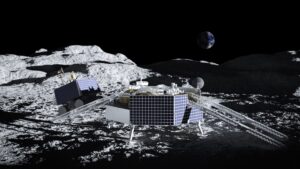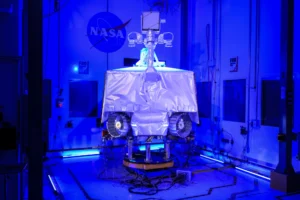NASA Cancels VIPER Lunar Rover
NASA announced today that it intends to cancel the highly-anticipated VIPER lunar rover that was to search for water ice at the Moon’s South Pole. Stressing that the VIPER team did outstanding work, NASA officials blamed the decision on cost growth at a time when NASA’s science budget is under severe constraints as Congress demands deep cuts to federal spending.
VIPER, the Volatiles Investigating Polar Exploration Rover, is designed to roam around the lunar South Pole for 100 days searching for water ice with scientific instruments and a 1-meter (3.3-foot) drill. Previous NASA probes have detected evidence that water, possibly deposited by comets over the eons, exists in permanently shadowed regions at the Moon’s poles. VIPER would be a step in creating the first lunar water resource map.
Today, however, the head of NASA’s Science Mission Directorate, Nicky Fox, and Joel Kearns, who leads SMD’s Exploration Science Strategy and Integration Office (ESSIO), told reporters they have decided to cancel the program due to cost growth.
Fox did acknowledge that it is NASA’s intent to terminate VIPER, but Congress will have the last word. NASA has notified the congressional appropriations committees and is waiting for a response. She said she’ll be “happy to have any discussions that they wish to have.”
NASA’s science budget is bearing the brunt of budget cuts resulting from last year’s Fiscal Responsibility Act. The FRA was negotiated by then-House Speaker Kevin McCarthy and President Biden in response to House Republican demands for deep cuts in federal spending in return for Congress suspending the debt limit.
NASA’s FY2024 budget was cut more than $2 billion from Biden’s request and is two percent less than its FY2023 level. The science budget is $1 billion less than the request.
The agency already made a difficult decision to reconsider the Mars Sample Return mission because its cost was growing. Now VIPER is in the cross hairs.
When then-NASA Administrator Jim Bridenstine revealed the project at the 2019 International Astronautical Congress, the estimated cost was $250 million. By the time NASA was ready to make a cost commitment to Congress, that grew to $433.5 million with landing in 2023. That landing date slipped to 2024 with a cost of $505.4 million. Now it has slipped again to 2025 and with a cost of $609.6 million, more than 30 percent above the commitment. That triggered an automatic cancellation review, Kearns said, which took place last month.

Kearns cited several reasons for the cost growth. In particular, VIPER was hit hard by supply chain issues due to the COVID pandemic that persisted and led to delivery delays in critical components.
In addition, NASA decided to rely on a commercial provider, Astrobotic, to develop the lander to take VIPER to the Moon as part of the Commercial Lunar Payload Services (CLPS) program. Through CLPS, NASA purchases services rather than building, owning and launching lunar landers itself. NASA provides science and technology payloads to be delivered to the surface of the Moon and pays for those services. The companies are expected to find other customers to close their business cases.
NASA’s first CLPS contract with Astrobotic was for use of its small Peregrine lander. For VIPER it needed a larger lander, Griffin. Even before the launch of Peregrine in January of this year, NASA wanted to ensure that Griffin’s propulsion system was up to the job and decided to delay VIPER’s launch and pay for extra tests contributing to the cost growth to $505.4 million.
Peregrine never landed on the Moon because of a propulsion failure. That meant further delays in developing Griffin and therefore launching VIPER.
Kearns said Griffin won’t be ready until at least September 2025. The $609.6 million estimate assumes that launch date, but NASA’s worries there may be further delays, which would mean even higher costs.
The CLPS contract with Astrobotic will continue, however. That $323 million contract is in addition to VIPER, so the total cost of the mission would be almost $1 billion. NASA’s Office of Inspector General criticized NASA in 2022 for a lack of transparency on VIPER’s cost by excluding the CLPS contract.
Astrobotic will move forward with sending Griffin to the Moon without VIPER, instead carrying payloads for whatever commercial customers it has. In a statement tonight, Astrobotic CEO John Thornton said they are looking at how best to utilize the mission.
“Astrobotic remains committed to flying our Griffin Mission One to the Moon as soon as possible. Although the Griffin lander was optimized to fly NASA’s VIPER, we are engaging in conversations with multiple customers about different payloads to fly on Griffin. We’ve been investing heavily in lunar power infrastructure over the last few years, and pioneering a lunar power grid service, called LunaGrid. One possibility we’re looking at closely is a LunaGrid-related demonstration mission. We’re also soliciting and reviewing new payload proposals. The decisions must be made quickly, but we’re considering all options.” — John Thornton
Kearns said NASA has spent about $450 million on VIPER so far, not including the CLPS contract, and estimated the agency will save $84 million by cancelling it.
The rover is completely assembled, but has not been through testing. NASA will consider “expressions of interest” from industry or international partners by August 1 for use of VIPER at no cost to the U.S. government, but otherwise the rover will be disassembled and the instruments and components used on other missions.

Fox and Kearns expressed optimism about the CLPS initiative overall. A second CLPS mission by another company, Intuitive Machines, was somewhat more successful in February. Two more are planned this year, a second by Intuitive Machines and another by Firefly, and several more are on the books or planned.
Managed by NASA’s Ames Research Center in Mountain View, California, VIPER is the second California-based NASA mission this year to get bad news.
The Mars Sample Return mission, managed by the Jet Propulsion Laboratory in Pasadena, was first. JPL laid off 8 percent of its workforce when NASA cut back spending, prompting backlash from many members of the California congressional delegation. The House Appropriations Committee is directing NASA to spend more on MSR in FY2025 than requested even though the science budget overall would be cut. MSR hasn’t been canceled, but NASA is looking for less expensive alternatives.
How they will react to this VIPER decision will be interesting to watch especially since $450 million has been spent already and only $84 million will be saved by terminating it.
User Comments
SpacePolicyOnline.com has the right (but not the obligation) to monitor the comments and to remove any materials it deems inappropriate. We do not post comments that include links to other websites since we have no control over that content nor can we verify the security of such links.